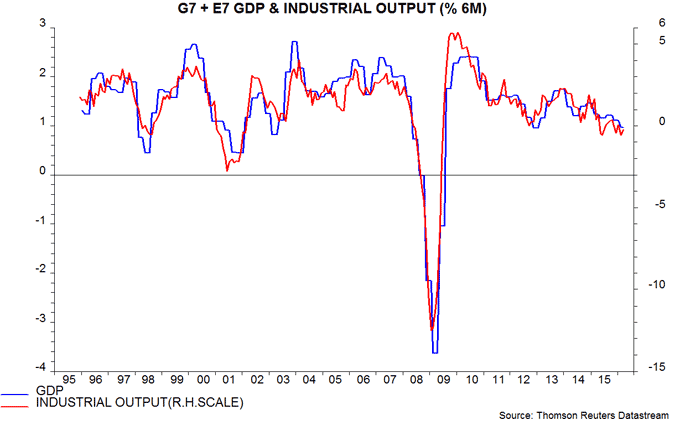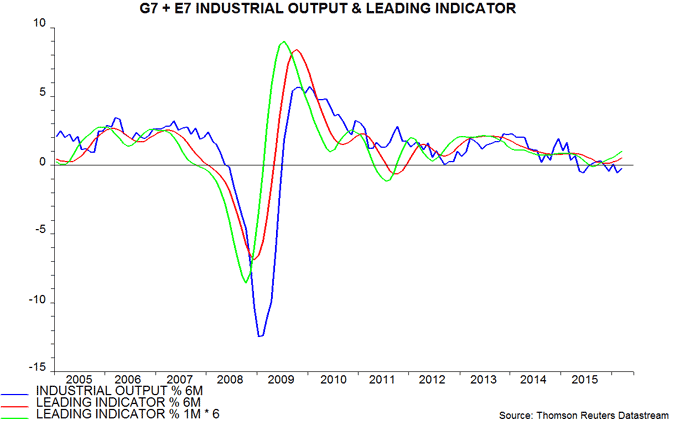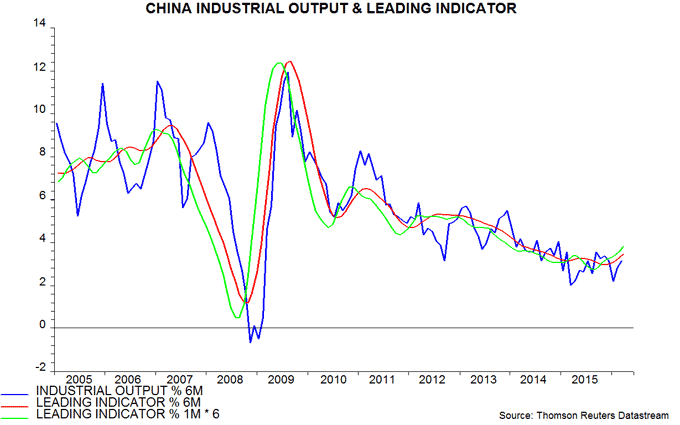Entries from May 8, 2016 - May 14, 2016
China money signal still positive
Partial money / credit data for April show a slowdown in financing flows last month but narrow money growth appears to have remained solid, supporting a positive view of near-term economic prospects.
“Total social financing” (TSF, a broad measure of fund-raising by households and non-financial enterprises covering bank / non-bank loans and issuance of bonds, acceptances and equities) rose by an annual 13.1% in April, down from 13.4% in March and below an average of 17.3% over 2011-15 (five years) – see chart. Monthly growth adjusted for seasonal factors is estimated here to have declined to only 0.4% last month from 1.0% in March.
Some commentators have raised concerns about much faster recent growth of total bank lending, including credit flows to the financial sector and government. Strong financial sector lending appears to reflect a “reintermediation” of shadow banking business rather than a “hidden” flow of new credit to households and non-financial enterprises. Government credit has been boosted by fiscal stimulus efforts. TSF is the best measure of new liability creation by households and enterprises and does not suggest another credit “bubble” – see previous post for more discussion.
Narrow money, as measured by “true M1”*, is judged here to the most reliable monetary leading indicator of economic activity. An April reading for true M1 is not yet available but annual growth of the official M1 measure rose further to 22.9% in April, the fastest since 2010 – see chart.
Further analysis will be posted when additional April data become available next week.
*”True” M1 = currency in circulation plus demand / temporary deposits of households and corporations. The official M1 measure excludes household deposits.

UK money trends signalling medium-term inflation rise
UK inflation is judged here to have embarked on a medium-term upswing – see previous post. This view rests partly on the “monetarist” proposition that changes in inflation follow changes in monetary growth with long lag (typically of 1-2 years, according to Friedman and Schwartz). Annual broad money growth, as measured by “non-financial M4” (comprising money holdings of households and private non-financial corporations), has risen significantly since 2011, reaching 6.3% in March, the fastest since 2008.
The chart presents long-run evidence in favour of the proposition that money growth changes reliably lead inflation swings*. The upper panel of the chart show a measure of annual “core” retail price index (RPI) inflation**. The RPI is used because core consumer price inflation data do not extend back before 1997. The bottom panel shows annual non-financial M4 growth.
The labels on the two lines show turning points identified by a numerical procedure (the Bry-Boschan algorithm). There have been 32 turning points in core inflation since 1953, i.e. 16 peaks (odd number labels) and 16 troughs (even numbers).
The procedure identifies 41 turning points in broad money growth over a slightly longer period starting in 1951. The number labels reflect an attempt to pair the inflation turning points with prior or nearby money growth peaks / troughs.
This exercise provides support for the monetarist view that a reliable leading relationship exists. 30 of the 32 inflation turning points have a readily-identifiable money growth counterpart. The only inflation swing that cannot be associated with a money growth move is the minor decline between 2002 and 2005, i.e. points 25 and 26***. The average lead time between money growth turning points and their identified inflation counterparts is 27 months.
There are 11 money growth turning points that have no assigned inflation counterpart, labelled “X”. However, 3 of these occur at the beginning and end of the sample period and should be discarded (because the corresponding inflation turning points are out of range). That leaves 8 “false” signals to explain.
2 of these false signals relate to a rise in broad money growth between 1979 and 1981 that was not followed by an increase in inflation. Most of this rise, however, occurred after the removal in June 1980 of penalties**** on banks’ balance sheet expansion – this resulted in the “reintermediation” of banking business that had been channelled through parallel markets. Narrow money growth, by contrast, fell sharply in 1979-80. These 2 false signals, therefore, are explicable by a distortion to the broad money data.
Of the remaining 6 false signals, 4 relate to small movements in money growth (i.e. in 1994 and 1998-99). While identified by the algorithm, it is doubtful whether an economist analysing the data at the time would have deemed the changes significant.
The results, overall, are encouraging. Money growth appears to have signalled 30 out of 32 inflation turning points, with only 2 significant and unexplained false indications.
What is the current message? Broad money growth made a major low in August 2011, with a suggested corresponding core inflation trough in April 2015. Money growth rose until June 2013, retreating slightly to a low in July 2014 before resuming an increase to a new post-recession high. Based on the average 27-month lead at turning points, the rise since July 2014 suggests that core inflation will be on an upward trend from late 2016, with no peak until mid-2018 at the earliest.
*A longer research note is available on request.
**Core inflation is used because headline inflation is regularly “shocked” by influences unrelated to domestic monetary conditions, such as global commodity price swings and changes in indirect taxes and administered prices. The core RPI definition here excludes mortgage interest, food, alcohol, tobacco, fuel & light, petrol & oil, council tax / rates and housing depreciation, and adjusts for VAT changes in July 1979, April 1991, December 2008, January 2010 and January 2011, and the change in undergraduate tuition fees over 2012-14.
***Core CPI (rather than RPI) inflation was stable over this period.
****The supplementary special deposits scheme, known as the “corset”.
Global leading indicators supporting recovery scenario
The OECD’s composite leading indicator indices are showing brighter signs, consistent with the view here that global economic growth will recover after a weak start to 2016.
Available data suggest that two-quarter GDP growth in the G7 major countries and seven large emerging economies (the “E7”) slipped to its lowest level since 2012 in the first quarter of 2016. (Growth is measured over two quarters to reduce volatility.) G7 plus E7 industrial output, meanwhile, was stagnant over the six months to March – see first chart.
The second chart shows changes in industrial output and a G7 plus E7 leading indicator based on the OECD’s country data. Six-month growth of the indicator rose again in March, having bottomed in November 2015. The one-month indicator change also continues to firm.
The upturn in leading indicator momentum is consistent with a rise in G7 plus E7 six-month real narrow money growth from a low in August 2015 – third chart. The latter pick-up was noted in a post at end-2015, which concluded that “global economic momentum will remain soft in early 2016 but rise in the spring / summer”. (Note that real narrow money has expanded consistently faster than industrial output / GDP in recent years, reflecting super-low interest rates, which have reduced the opportunity cost of holding demand / sight deposits and physical cash. Changes in real money growth, however, continue to foreshadow changes in economic expansion six to 12 months ahead.)
The stronger signal from the leading indicator mainly reflects an upturn in the E7 component, although G7 weakness is abating. The OECD’s Chinese leading indicator, in particular, is giving a positive message, consistent with an earlier upswing in real narrow money growth – fourth chart. A recent resurgence of pessimism about Chinese economic prospects appears premature, at least.

